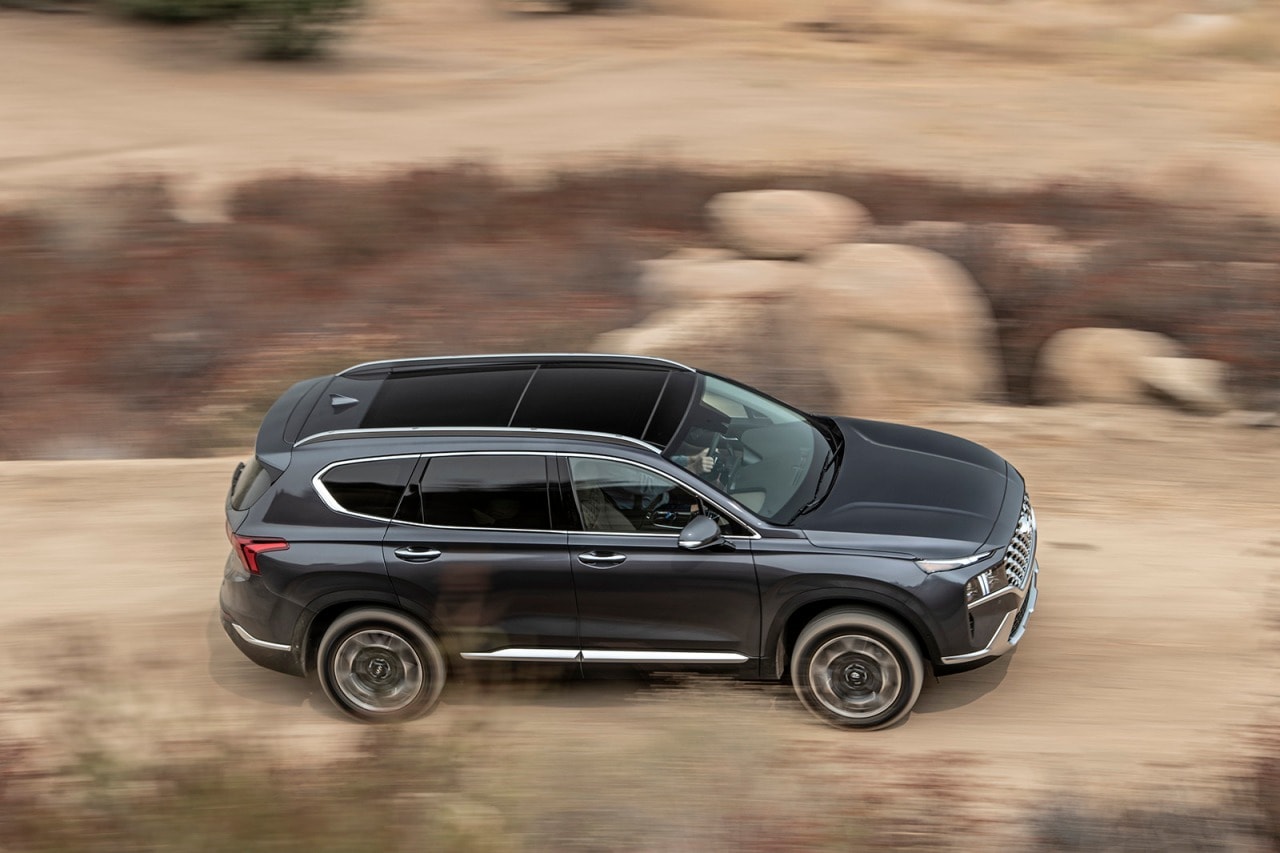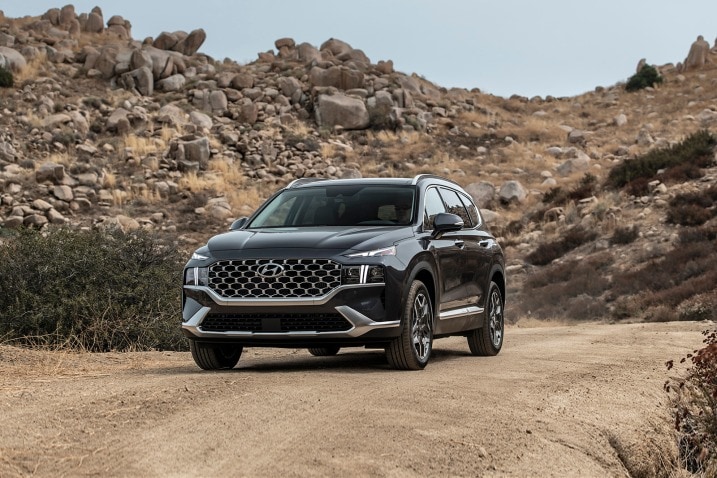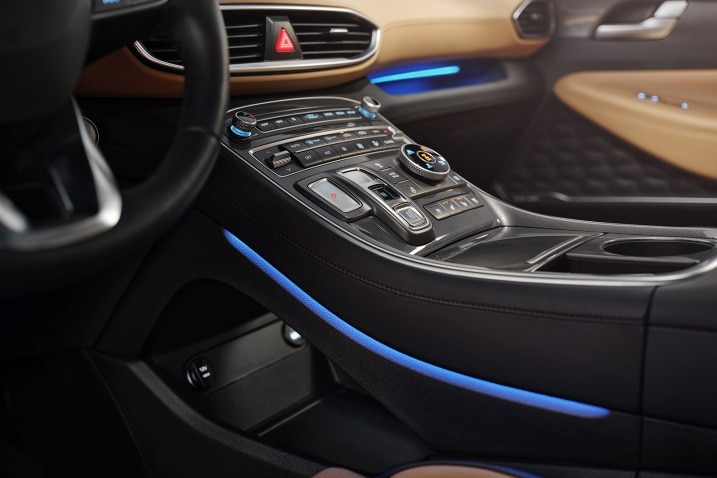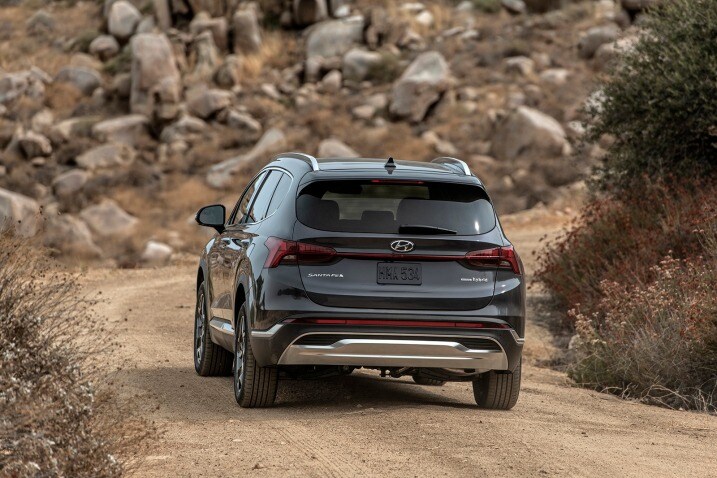- Plug-in hybrid powertrain adds electrification to the Santa Fe lineup
- Provides about 30 miles of all-electric range
- Two-trim lineup keeps things simple
- Part of the fourth Hyundai Santa Fe generation introduced for 2019
2022 Hyundai Santa Plug-In Hybrid Isn't Amazing Once It Runs Out of Juice
What is the Santa Fe PHEV?
The Santa Fe is a two-row SUV that slots in between the compact Tucson and three-row Palisade. It's been a staple in Hyundai's lineup for more than 20 years and was one of the brand's first SUVs. Though it's been a part of Hyundai's ascendancy from budget-brand to near-premium automaker, the current Santa Fe, which has been out since 2019, needs something fresh to leave a real impression on us.
Luckily, Hyundai's done just that and added an all-new plug-in hybrid (PHEV) powertrain to the 2023 Santa Fe. It allows you to drive a short distance on all-electric power before switching over to operate like a regular hybrid. You can recharge it at home or at a public charging station, and doing so frequently can really help reduce your use of gas.
As for the Santa Fe's contenders, this group consists of rivals such as the Santa Fe's corporate cousin, the Kia Sorento Plug-In Hybrid, as well as slightly smaller SUVs such as the Ford Escape Plug-In Hybrid and Toyota RAV4 Prime.
So does the new Santa Fe Plug-In Hybrid broaden the Santa Fe's appeal or should you just stick with the more conventional gas engine option? Read on to find out.
What's under the Santa Fe PHEV's hood?
The powertrain itself consists of a turbocharged 1.6-liter turbocharged four-cylinder engine and a hybrid system that combine to produce a total output to 260 horsepower and 258 lb-ft of torque. Power is sent through a six-speed automatic transmission to all four wheels.
How does the Santa Fe PHEV drive?
Any plug-in hybrid is at its very best when the battery is fully charged and the car can intelligently switch between the battery or the gas engine to suit the situation. Drain the battery, however, and a PHEV instantly turns into an even heavier version of a normal hybrid because of its bigger battery.
This drained, bogged-down state is the only chance we had to sample the Santa Fe Plug-In Hybrid. Simply put, this powertrain wasn't at its best. A few attempts were made to pump juice back into the pack by coasting and using the Santa Fe's brakes, but no dice. Each attempt to put it in EV-only mode was met with the equivalent of a "sorry, no juice" error message from the instrument cluster. Off the line or up steep grades, the 1.6-liter engine felt labored.
As a result, we can't give an honest assessment of the Santa Fe's PHEV powertrain until we get one for our own in-house testing to top up both the tank and the battery to give it a chance to put on a good showing.
When it comes to other aspects of the Santa Fe, however, the news is good. The brakes blend regenerative braking and friction braking well, and it's easy to come to a smooth stop in city traffic.
There are different drive modes to fiddle with via a rotary knob in the center console, but we found little use for Sport or Snow. Instead we left it in Smart and let the computer sort out how to best juggle what little power from the battery we had and how to best sort the gearing for max efficiency. The transmission itself is unobtrusive and rarely hunts for gears, except on steeper inclines. Thankfully, when it does shift, it does so snappily. Just six gears might seem middling in 2022, but it's based on Hyundai's modern eight-speed automatic with two gears taken out and the hybrid electric motor now taking up that space.
All in all, we think the PHEV powertrain could add to the Santa Fe's appeal — we just need to test it at its best to be sure.
How comfortable is the Santa Fe PHEV?
Like other Santa Fe models, the PHEV is a comfortable place to spend some time. The interior is hushed at most any speed, and on different types of pavement there's little tire drone to speak of. We were able to carry on with a quiet conversation during the duration of our drive, not once having to raise our voices to match the level of unwanted noises, vibrations or harshness. It's also cavernous up front, with enough legroom for taller occupants and comfortable seats that will accommodate a wide range of body types.
It isn't perfect, however, and the Santa Fe's rear pillars compromise visibility and make this crossover-sized car feel bigger than it is. We also found the PHEV model to occasionally be too floaty for our liking. The suspension is tuned with comfort in mind, and some wallowing is OK, but it frequently felt like the Santa Fe's suspension wasn't completely able to control the body's mass. The result is the sensation of being rocked about on a small boat by a passing mega-yacht's wake.
How's the Santa Fe PHEV's interior?
The interior itself has not changed at all for the Santa Fe Plug-In Hybrid, so all of our likes and dislikes from other models carry directly over. There's good small-item storage, and the cargo hold is truly massive. A generous glovebox and deep center console only bolster the Santa Fe's family-hauler credentials. So does its large rear seat area and gobs of headroom for both front and rear seat riders — even with a full-length glass roof.
The main gripe we have always had with the Santa Fe's interior is the extremely button-heavy center console. We like buttons, and it would seem counterintuitive to complain about something like this as most automakers move to touch-sensitive controls. However, the arrangement of the 36 buttons, three knobs and two switches is far from logical and makes using the interface without looking nearly impossible.
Breaking up the mass of buttons by mounting the radio controls on the dashboard and leaving some free space in the center console area might clean things up, but Hyundai is sticking with this layout for the foreseeable future. Think heavily about how many buttons you can handle, and if you're up to the task of getting used to all of them, before you settle on a Santa Fe.
How's the Santa Fe PHEV's tech?
The Santa Fe PHEV Limited, which is what we drove, gets the same 10.25-inch infotainment display and 12.3-inch digital instrument cluster as other top-spec Santa Fes. There are loads of features packed into the Limited trim, including heated and front ventilated seats, a heated steering wheel and a Harman Kardon sound system.
On the safety side, all Santa Fe PHEVs come with key features including blind-spot monitoring, rear cross-traffic alert, adaptive cruise control and lane keeping assist. The combination of the adaptive cruise and lane keeping does a good job of keeping you within a lane and following the car in front of you at a consistent speed and distance. It won't, however, change lanes for you and is regularly fooled when lane guidance lines disappear.
How economical is the Santa Fe PHEV?
The EPA estimates the 2023 Santa Fe Plug-In Hybrid can go about 30 miles on all-electric power with a fully charged battery. After the battery runs out, expect to get 33 mpg in combined city/highway driving, the EPA says. Both figures are a little less than what you can get from a RAV4 Prime, which boasts 42 miles of electric range and 38 mpg combined.
Edmunds says
The Santa Fe Plug-In Hybrid is a fine alternative to the solely gas-powered version of the Santa Fe. If you want something efficient, quiet, tech-packed and spacious, it's worth a look. But it seems only at its very best if you can keep that battery charged, but we won't know for sure until we're able to put this PHEV through our full range of testing.









 by
by